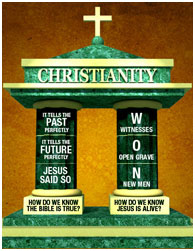
The Bible Tells the
Past Perfectly
Archeology has shown the history in the Bible to be correct down to the smallest detail.

Use these links for more details
How can we tell if the Bible is historically accurate?
Historians judge the reliability of writers by whether or not they can get the details right. The biblical writers gave hundreds of geographic names, the titles and names of government officials, and many other details that would have been know only by someone who lived at that time and in that location. These details from the Bible have been verified by archaeological finds and other non-Biblical sources. These demonstrate that the Bible is very reliable as a historical source of information.
Non-Biblical Writings
A Jewish/Roman historian named Flavius Josephus
According to Wikipedia, “Josephus recorded Jewish history, with special emphasis on the 1st century AD and the First Jewish–Roman War, including the Siege of Masada, but the imperial patronage of his work has sometimes caused it to be characterized as pro-Roman propaganda.” However, even within the many volumes of this “pro-Roman propaganda," Josephus wrote about; John the Baptist, Jesus, James, the high priests Annas and Caiaphas, the Herods, and Roman emperors mentioned in the Gospels and Acts.
Even though the exact wording is unclear in one of Josephus’ references to Jesus, even liberal scholars concede that the passage gives us some very important information which confirms what the Bible says about Jesus:
1. He was a real historical person
2. He was a teacher
3. He was a worker of wonders (miracles)
4. He gathered a band of followers, who continued to follow him after his death.
In the second reference to Jesus in Josephus’ work (Antiquities 20.200), Josephus describes how, “in AD 62, the high priest Annas was deposed because he had illegally convened the Sanhedrin [the highest Jewish religious court / governing body]. He had brought before them the brother of Jesus the so-called Christ, who was called James, and some other men, whom he accused of having broken the law, and handed them over to be stoned.”
In this passage we learn that Josephus confirms several things that the Bible says:
1. Jesus had a brother called James
2. James was executed by the Jewish leaders in AD 62
3. There were claims that Jesus was the Messiah (that is, the Christ).
The Jewish Talmud
Even the Jewish Commentaries, called the Talmud, mentioned Jesus a number of times.
Many Additional Non-Christian Sources
Those who claim that Jesus never even lived just haven't looked at the ancient historical records very closely. Dr. Gary Habermas, in his book The Verdict of History, lists 39 non-Christian ancient sources documenting the life of Jesus. From them he has found more than 100 facts which corroborate the Gospels with regard to Jesus' life, teachings, crucifixion and resurrection.
Archaeological Finds
Luke’s Writings
Luke’s Gospel and the Book of Acts accurately names 32 countries, 54 cities and 9 islands. He also gives details that would not have been known accept by someone who lived in that time and region, such as the exact titles of officials and the identification of army units.
Dead Sea Scrolls
John’s Gospel uses phraseology, symbolism, and conceptual imagery that was once thought to be proof that his gospel was written much later. However, the Dead Sea Scrolls have shown that those things were used by certain groups during the time of Christ.
Pavement Inscription
Paul in Romans 16:23, and Luke in Acts 19:22 mention a public official named Erastus. Archeological excavations in Corinth, Greece discovered a pavement inscribed with these words, “Erastus, curator of public buildings, laid this pavement at his own expense.”
Skeptical Archaeologist Convinced
According to Wikipedia, “By his death in 1939 [Sir William Ramsey] had become the foremost authority of his day on the history of Asia Minor and a leading scholar in the study of the New Testament. Ramsey’s level of expertise on the New Testament was the result of his many years attempting to discredit the writer of the Book of Acts. In Ramsey’s day, most of the New Testament was thought to have been written more than a hundred years after the events to which it's writer claimed to have been a contemporary. Ramsey “fully expected his own research to prove the author of Acts hopelessly inaccurate since no man could possibly know the details of Asia Minor more than a hundred years after the event.” “When he first went to Asia Minor, many of the cities mentioned in Acts had no known location and almost nothing was known of their detailed history or politics... He therefore set out to put the writer of Acts on trial. He devoted his life to unearthing the ancient cities and documents of Asia Minor. After a lifetime of study, however, he concluded: ‘Further study . . . showed that the book could bear the most minute scrutiny as an authority for the facts of the Aegean world, and that it was written with such judgment, skill, art and perception of truth as to be a model of historical statement’ (The Bearing of Recent Discovery, p. 85).”
“When Ramsay turned his attention to Paul’s letters, most of which the critics dismissed as forgeries, he concluded that all thirteen New Testament letters that claimed to have been written by Paul were really his.”
Summary
Hundreds of additional examples could be sited, but the fact that every archaeological find that has had anything to do with the Bible has comfirmed the truth of the Bible means that it is completely reliable as a collection of historical documents. There are also nearly 40 ancient non-Christian sources which corroborate the life, teachings, crucifixion and resurrection of Jesus!
>
Design, graphics and artwork copyright © 2019 Tim Beasley • All rights reserved.